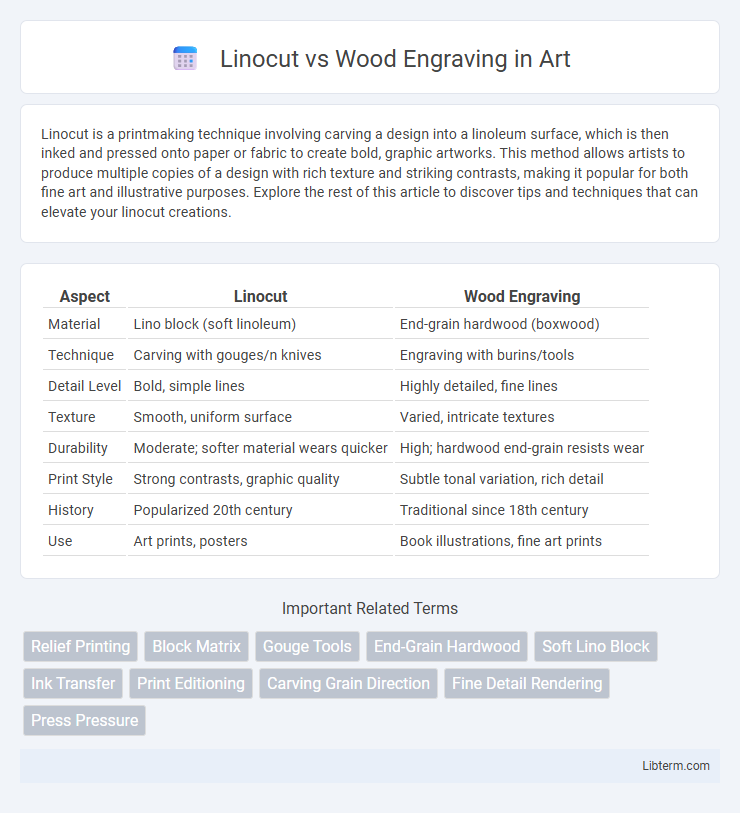Linocut is a printmaking technique involving carving a design into a linoleum surface, which is then inked and pressed onto paper or fabric to create bold, graphic artworks. This method allows artists to produce multiple copies of a design with rich texture and striking contrasts, making it popular for both fine art and illustrative purposes. Explore the rest of this article to discover tips and techniques that can elevate your linocut creations.
Table of Comparison
| Aspect | Linocut | Wood Engraving |
|---|---|---|
| Material | Lino block (soft linoleum) | End-grain hardwood (boxwood) |
| Technique | Carving with gouges/n knives | Engraving with burins/tools |
| Detail Level | Bold, simple lines | Highly detailed, fine lines |
| Texture | Smooth, uniform surface | Varied, intricate textures |
| Durability | Moderate; softer material wears quicker | High; hardwood end-grain resists wear |
| Print Style | Strong contrasts, graphic quality | Subtle tonal variation, rich detail |
| History | Popularized 20th century | Traditional since 18th century |
| Use | Art prints, posters | Book illustrations, fine art prints |
Introduction to Linocut and Wood Engraving
Linocut is a relief printing technique where artists carve into smooth linoleum sheets, creating bold, graphic designs with a softer texture compared to traditional woodcuts. Wood engraving involves carving fine details into the end grain of hardwood blocks, allowing for intricate line work and high durability during printing. Both techniques offer distinct artistic effects, with linocut favoring expressive, larger shapes and wood engraving excelling in precision and detail.
Historical Origins of Linocut and Wood Engraving
Linocut originated in the early 20th century as an affordable and accessible printmaking technique using linoleum sheets, gaining popularity among modern artists for its ease of carving and bold graphic style. Wood engraving dates back to the late 18th century, evolving from traditional woodcut methods with artists using end-grain hardwood blocks, allowing for fine detail and intricate textures essential in book illustrations during the Victorian era. Both methods reflect distinct historical contexts where linocut emerged from modernist innovation and wood engraving from print media craftsmanship.
Materials and Tools Used in Each Technique
Linocut utilizes linoleum blocks, carving tools with rounded or V-shaped blades, and water-based or oil-based inks for printing, making it more flexible and easier to carve than wood. Wood engraving involves hardwood blocks, typically boxwood, and requires fine, precise engraving tools such as Burins to cut intricate details into end-grain surfaces. The distinct materials and tools in each technique influence the texture and detail achievable in the final print, with linocut offering bolder lines and wood engraving enabling finer, more detailed imagery.
Differences in Artistic Process
Linocut involves carving a smooth linoleum surface with gouges, creating bold and graphic prints due to the material's softness and uniform texture. Wood engraving utilizes the end grain of hardwood blocks, allowing for finer details and intricate lines achieved through precise use of burins and engraving tools. The linocut's quicker, more intuitive cuts contrast with the wood engraving's meticulous, time-intensive approach, resulting in distinct artistic textures and tonal variations.
Visual Characteristics and Aesthetic Results
Linocut prints typically feature bold, clean lines and high contrast due to the smooth, uniform surface of the linoleum, resulting in a graphic, modern aesthetic with sharp edges and minimal texture. Wood engraving offers intricate details and rich texture from the fine grain of hardwood, enabling subtle tonal variations and a more refined, delicate appearance. The visual characteristics of wood engraving emphasize depth and complexity, while linocut prioritizes simplicity and striking visual impact.
Durability and Print Edition Potential
Linocut blocks, made from softer linoleum material, tend to wear down more quickly, limiting their durability and reducing the number of high-quality prints possible in large editions. Wood engraving utilizes dense hardwood, such as boxwood, offering exceptional durability that supports thousands of detailed prints without significant degradation. This durability makes wood engraving ideal for producing long print runs and maintaining consistent detail throughout extensive editions.
Common Applications and Artistic Uses
Linocut often serves artists seeking bold, graphic prints for posters, fine art prints, and fabric designs due to its softer material allowing easier carving. Wood engraving is favored for detailed illustrations in books, newspapers, and high-quality prints, utilizing end-grain hardwood for fine lines and intricate textures. Both techniques cater to creative expression but differ in precision level, with linocut offering striking contrasts and wood engraving enabling meticulous detail.
Learning Curve and Accessibility
Linocut offers a gentler learning curve due to its softer carving surface and straightforward tools, making it more accessible for beginners and hobbyists. Wood engraving requires mastering intricate techniques on harder end-grain wood, demanding greater precision and patience, which can pose challenges for newcomers. The affordability and ease of sourcing linoleum compared to specialized wood blocks contribute to linocut's wider accessibility in printmaking education.
Notable Artists in Linocut and Wood Engraving
Notable artists in linocut include Pablo Picasso and Henri Matisse, who utilized the medium for its bold, graphic qualities and ease of cutting. Key figures in wood engraving encompass Thomas Bewick and Eric Gill, pioneers known for their detailed, fine-line work that revolutionized book illustration. Both techniques attracted artists for their distinct textures and expressive potential, with linocut favored for modernist experimentation and wood engraving celebrated for intricate craftsmanship.
Choosing Between Linocut and Wood Engraving
Choosing between linocut and wood engraving depends on the desired level of detail and texture in the print. Linocut offers bold, graphic lines and is easier to carve, making it suitable for beginners and projects requiring strong contrasts. Wood engraving provides finer detail and intricate textures due to its use of end-grain wood, preferred for highly detailed and delicate images.
Linocut Infographic

 libterm.com
libterm.com